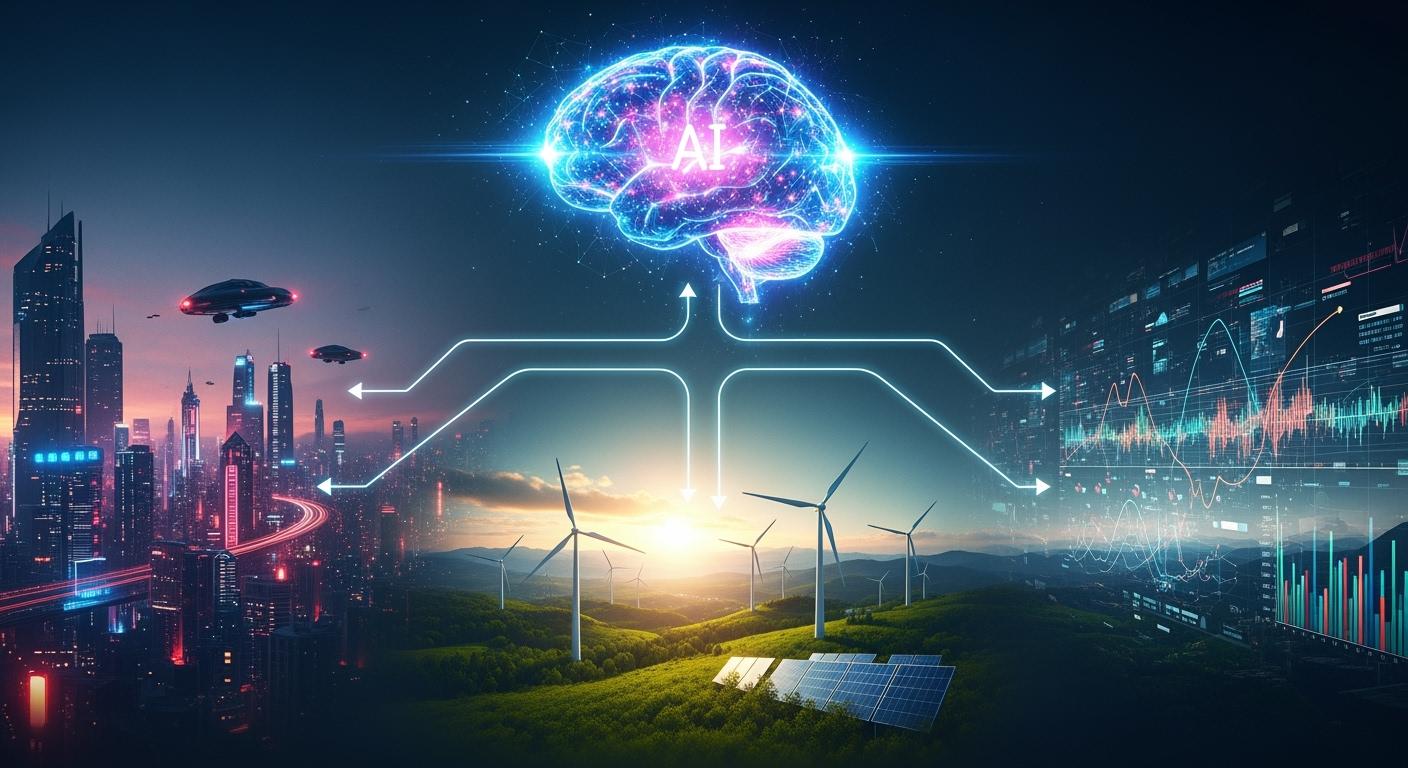
Constant geopolitical disruptions make traditional scenario planning insufficient. Businesses face new risks and great uncertainty. Machine learning offers a solution. It empowers better scenario planning and risk planning.
AI helps leaders simulate any scenario. This AI-driven strategy moves planning beyond old methods. AI identifies hidden risks. AI manages risk. AI reduces risk.
This proactive scenario planning helps manage every risk, future risk, and potential scenario.
Limits of Traditional Scenario Planning
Traditional scenario planning struggles in today's volatile world. Its methods were not designed for the speed and complexity of modern global risks. This older approach to planning often fails to provide the foresight businesses need. The process has fundamental limitations. These limitations expose companies to significant, unforeseen risks.
Cognitive Biases and Human Error
Human judgment is central to traditional scenario planning. Unfortunately, human minds have built-in biases. These biases can quietly undermine strategic goals and risk assessment efforts. Overconfidence and confirmation bias are two major culprits in poor planning. They lead executives to misjudge risks and ignore critical warning signs. This flawed risk assessment creates a dangerous false sense of security.
Overconfidence causes leaders to overestimate their abilities. They create ambitious strategies that overlook potential risks. Deutsche Bank’s aggressive global expansion is a key example. Leaders believed they could replicate domestic success worldwide. They underestimated the complexities of international finance. This overconfidence led to catastrophic outcomes during the 2008 financial crisis.
Groupthink also harms the planning process. It occurs when teams prioritize consensus over critical thinking. This environment discourages new ideas and honest risk assessment. The consequences of groupthink are severe.
- Poor Decision-Making: Without diverse viewpoints, teams make choices without exploring all potential risks. This leads to a flawed scenario and a weak risk assessment.
- Missed Opportunities: The pressure to conform means creative solutions are often overlooked. This puts a company at a competitive disadvantage.
- Reduced Innovation: A lack of critical debate stifles the development of new strategies to manage risk.
Inability to Handle Geopolitical Risk
Traditional scenario planning cannot keep up with modern geopolitical shifts. The methods rely on slow, manual data collection. Analysts cannot process information fast enough to assess fast-moving geopolitical events. This makes effective geopolitical risk management nearly impossible. A company might analyze a specific scenario, but the global situation changes before the planning is complete.
Manual processes and fragmented software systems create inefficient and costly risk assessment workflows. This disjointed approach makes it difficult to monitor global risks and ensure compliance. Businesses struggle to understand complex geopolitical issues. They cannot perform an accurate risk assessment for each potential scenario. The slow pace of traditional planning leaves organizations vulnerable to sudden geopolitical shocks and their cascading effects.
The Machine Learning Advantage in Scenario Planning

Machine learning transforms scenario planning from a static exercise into a dynamic, intelligent process. AI gives businesses the power to analyze massive datasets, simulate complex futures, and monitor global risks in real time. This capability provides the data-driven insights needed for effective risk management in a volatile world. Leaders can move beyond reacting to crises and start proactively shaping their strategic responses to potential disruptions.
Uncovering Hidden Risks in Big Data
Traditional analysis often misses subtle warning signs buried in unstructured data. Machine learning excels at detecting these hidden risks. AI algorithms sift through immense volumes of "signal traffic" from diverse sources. This provides an early warning system for emerging threats. An AI can perform a detailed risk assessment by analyzing information that human teams cannot process at scale.
AI uses Natural Language Processing (NLP) to understand and analyze text. For example, NLP models identified respiratory illness from medical imaging before the official rise of COVID-19 cases. This shows the power of AI to find early warning signs. This technology gives planners a critical head start.
AI systems continuously scan various data streams to identify patterns and anomalies. This proactive risk assessment helps organizations anticipate problems before they escalate. Key sources for this geopolitical analysis include:
- News and Policy: AI analyzes news articles and policy shifts to gauge public opinion and identify potential geopolitical risks.
- Social Media: AI models mine social media posts, blogs, and forums for customer sentiment, helping to spot brewing PR crises or shifts in market trends.
- Customer Feedback: AI processes customer reviews and support emails to flag product issues or declining satisfaction, which are important risk signals.
This comprehensive approach to risk assessment ensures that no stone is left unturned in the planning process.
Simulating a Complex Scenario
Traditional scenario planning is limited to a few, manually crafted scenarios. This approach fails to capture the complexity of modern disruptions. AI enables dynamic scenario modeling on a massive scale. Businesses can simulate thousands of multiple scenarios to understand the full range of possible outcomes. This advanced modeling is crucial for a robust risk assessment.
AI uses sophisticated machine learning models to map out cascading effects. For instance, a company can model how a geopolitical event in one region could create production delays, which then cause supplier defaults and price hikes across the entire supply chain. This level of detail moves planning beyond simple "what-if" questions. It provides a clear picture of how different risks interact. Key modeling techniques include:
- Monte Carlo Simulations: These models use random sampling to predict a range of outcomes for a scenario, quantifying risk and uncertainty.
- Agent-Based Modeling (ABM): This approach simulates the actions and interactions of individual agents, like suppliers or consumers, to see how their collective behavior impacts the broader system.
- Artificial Neural Networks (ANNs): These AI models can act as powerful surrogates for other simulations, allowing for rapid analysis of a complex scenario.
This powerful modeling capability allows leaders to test their strategies against a wide spectrum of potential disruptions and build more resilient plans.
Enabling Dynamic, Real-Time Monitoring
The world does not stand still after a planning session. A scenario can change in an instant. AI enables continuous, real-time monitoring to keep scenario planning relevant. AI models automatically update risk assessments as new data becomes available. This ensures that strategies adapt to changing conditions.
An AI-powered dashboard becomes the central hub for strategic foresight. It integrates real-time data streams, tracks key risk indicators, and visualizes the potential impact of emerging threats. This gives leaders an up-to-the-minute view of their risk landscape.
These systems use adaptive learning to refine their understanding of risk over time. When a significant geopolitical event occurs, the AI automatically recalibrates the risk assessment for each relevant scenario. This automation allows teams to focus on strategic decision-making instead of manual data collection. The technical processes behind these powerful dashboards are complex.
- Data Preprocessing: AI systems clean, normalize, and structure incoming data from countless sources for analysis.
- Model Architecture: They use advanced AI models like Recurrent Neural Networks (RNNs) to understand temporal patterns and Transformer models to recognize complex relationships in the data.
- Uncertainty Quantification: The AI performs probabilistic forecasting and sensitivity analysis to measure the level of risk and confidence in each prediction.
This dynamic approach transforms scenario planning from a periodic event into an ongoing, intelligent function that protects the business from unexpected geopolitical and market shocks.
Practical Applications and Use Cases

Theoretical advantages are valuable, but practical applications demonstrate the true power of machine learning. AI is not just a concept for the future; it is a tool companies use today for effective risk management. It transforms how organizations build resilience and navigate complex global risks. The technology provides tangible solutions for some of the most pressing business challenges.
Building Supply Chain Resilience
Modern supply chains are global, complex, and fragile. A single point of failure can cause massive disruptions. AI provides the tools for building true supply chain resilience. It moves companies from a reactive posture to a proactive one. An AI can perform a detailed risk assessment on the entire supply chain network.
General Motors employs AI technologies to continuously monitor its supply chain. This AI-driven monitoring enables GM to anticipate and prevent production-halting events. The system achieves this through advanced mapping, news scanning, and data sourcing.
AI systems create a digital twin of a company's supply chain. This living model maps every supplier, route, and warehouse. The AI then analyzes this map to identify hidden risks. It can flag single-source vulnerabilities in high-risk geopolitical regions or suppliers showing financial distress. This detailed risk assessment is crucial for preventing potential disruptions. For example, a European automotive manufacturer used a dynamic supplier risk model.
- The AI, powered by machine learning, identified that a key component vendor was nearing bankruptcy.
- This early warning came two weeks before any public announcement.
- The alert gave the procurement team enough time to activate backup suppliers, completely avoiding costly supply chain disruptions.
This level of foresight is impossible with manual methods. AI-driven modeling allows leaders to simulate the impact of various potential disruptions. This capability strengthens resilience and protects against unforeseen risks.
Forecasting Geopolitical Impact
Geopolitical events create significant uncertainty for businesses. Elections, trade disputes, and new regulations can alter market conditions overnight. AI offers powerful geopolitical forecasting capabilities. It helps leaders anticipate the effects of geopolitical shifts and prepare their response. This proactive geopolitical risk management is essential for survival and growth.
AI models analyze vast datasets to perform a sophisticated risk assessment of the geopolitical landscape. They can forecast the impact of new environmental regulations on operational costs. For instance, a new machine learning approach, the Decision-Focused Learning (DFL) model, accurately forecasts energy costs for buildings. This allows property owners to manage usage and reduce expenses. This type of AI modeling has broad applications.
- Energy Management: AI can manage complex electric grids by forecasting supply and demand, offering strategies to optimize energy use.
- Regulatory Compliance: AI helps track progress toward pollution reduction goals, such as those related to corporate carbon footprints.
- Cost and Emission Reduction: In real-world tests, one AI-driven predictive model reduced CO₂ emissions by 30% and cut operational costs by 18%, showing its power in sustainable management.
This same AI technology applies to geopolitical forecasting for any scenario. A business can use AI to model how a trade dispute might affect market access or how an election could lead to new regulatory risks. The AI performs a risk assessment for each scenario, giving leaders a clear view of the potential financial and operational impacts. This advanced geopolitical analysis turns uncertainty into a strategic advantage, allowing companies to navigate geopolitical risk with confidence.
Implementing ML for Strategic Foresight
Adopting machine learning for strategic foresight requires a thoughtful approach. It involves combining powerful AI technology with human expertise. This integration is key to transforming scenario planning from a theoretical exercise into a practical, value-driving function. Companies can start this journey by understanding the roles of both humans and technology.
The Human-in-the-Loop Imperative
AI is a powerful partner, not a replacement for human strategists. The most effective risk management comes from a "cyborg approach." This method blends the computational power of AI with the contextual wisdom of human experts. While AI models can identify hidden risks, human oversight ensures the insights are relevant and actionable. This partnership is vital for a complete risk assessment.
Human judgment is essential for several reasons. It helps address the "black box" problem in complex AI models, ensuring decisions are transparent and explainable. This is critical for compliance in regulated industries.
Human oversight also prevents costly errors and mitigates bias. An unmonitored AI might misinterpret data, leading to financial loss or reputational damage. Experts must guide the AI, refine its modeling, and ensure its outputs align with strategic goals. This collaborative process makes the risk assessment for any scenario more robust and builds organizational resilience. Key human roles include:
- Validating AI outputs against real-world business knowledge.
- Correcting for biases that may exist in the training data.
- Interpreting complex geopolitical risks that AI may flag without full context.
Getting Started with Tools and Data
Beginning the journey with AI in scenario planning is more accessible than ever. Many platforms offer user-friendly interfaces for effective planning. These tools help bridge skill gaps and integrate with existing workflows.
- RapidMiner and Knime Analytics Platform allow teams to perform comprehensive data analysis without extensive coding knowledge.
- Organizations like StrategicFutures.ai offer programs that teach teams how to use AI for continuous horizon scanning to spot emerging disruptions.
Successful AI implementation starts with good data. A company does not need perfect data, but it must be organized. For a strong risk assessment, businesses should centralize key datasets. This includes financial results, operational performance metrics, and market indicators. This foundational data powers the machine learning models that drive better scenario planning and geopolitical risk management. With the right tools and data, any organization can develop contingency plans and build lasting resilience against geopolitical risk.
Integrating machine learning into scenario planning is a strategic necessity, not a luxury. This AI-driven strategy transforms planning, moving a business from reactive crisis management to proactive risk management. AI offers the power to anticipate geopolitical risk and model any scenario, a true survival skill in today's world of uncertainty. Mastering AI for scenario planning allows a company to navigate geopolitical risk. This advanced scenario planning turns risk into a competitive advantage. The AI handles every scenario and risk. AI reduces risk. AI manages risk. AI reduces risk.
FAQ
How does AI improve risk assessment?
AI systems analyze massive datasets to find hidden patterns. This process uncovers threats that human analysts might miss. The technology provides a more complete and data-driven risk assessment, leading to stronger strategic plans. This proactive approach helps manage every potential risk.
What data does a company need to start?
A business can begin with its existing data. Centralizing key information is the first step. Important datasets include:
- Financial performance records
- Supply chain and operational metrics
- Market and competitor data
This foundational data helps the AI model its first risk scenarios effectively.
Can small businesses use AI for scenario planning?
Yes. Many modern AI platforms are user-friendly and affordable. These tools allow small and medium-sized businesses to access powerful risk analysis capabilities. Companies no longer need large data science teams to start improving their resilience and managing geopolitical risk.
Does AI replace human experts in risk management?
No. AI is a tool that assists human experts. It automates data analysis, but human judgment is essential. Experts validate AI findings, interpret complex risk scenarios, and make the final strategic decisions. This partnership combines machine speed with human wisdom.
See Also
AI-Powered Production Forecasting: 2024 Enterprise Strategies for Superior Accuracy
Machine Learning Unlocks Fashion Trends, Significantly Boosting Retail Sales
Optimizing Brand Operations: AI-Powered Capacity Planning for Future Growth
Predicting Future Demand: AI and Data Strategies for 2025 Success
Five Real-Time Demand Forecasting Strategies for Immediate Business Impact